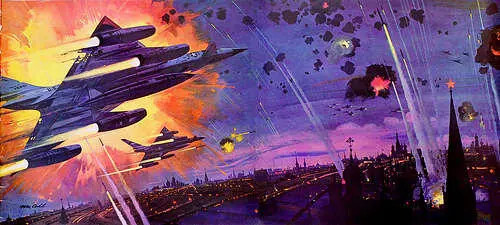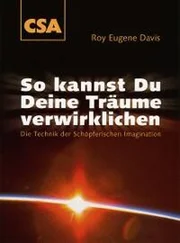The few men in the War Room who were talking fell silent.
“Put the Soviet fighter planes on the projection,” General Bogan said.
A flock of small white blips appeared, all of them meticulously grouped on the Soviet side of the red line.
“This is Enemy Defense Performance Desk, General Bogan,” a mechanical voice said. The desk was keyed to come on with an interpretation when its information was projected onto the Big Board. “The No. 6 plane, which carries only defensive equipment and devices has moved into the lead. Apparently it has already launched some masking devices for, as you can see, the Soviet fighters are not grouping at the point where Group 6 crossed the border. On their radars the targets probably appear spread over several hundred miles and they are starting to get blips on a good number of objects without being able to determine which are real and which are decoys.”
“Have they launched missiles of any kind?” General Bogan asked.
“Not yet,” the Enemy Defense Desk said.
At that moment the Soviet fighter command ordered its planes into action. Instantly the Big Board began to blossom. Blips raced up the board, homed on decoys, raced relentlessly down their electronic tracks and then detonated themselves in little mushrooming blips which quiddy disappeared.
“The little dots that appear suddenly and then disappear are missiles,” the Enemy Defense expert said. “The largest blips are fighter-bombers which are probably equipped with their own radar and air-to-air missiles. So far none of the antiaircraft shots have been nuclear. They are the conventional warhead. As you can see, our diversion and evasive devices are working well. The No. 6 plane which is now angling away will probably drop a new set of window.”
Each of the planes was equipped with radar-jamming and obscuring devices which were called “window” and were advanced developments from the older strips of foil designed to produce false images on enemy radar screens. The Vindicators also carried other decoys, some of which could be launched by small rockets, and antimissile missiles and automatic devices to detect and identify approaching enemy missiles and compute the precise time for firing the antimissile missiles.
“Right now the Soviet radar is probably picking up some hundreds of blips and they are running each of them down systematically,” the voice went on. “On the scope that you see the decoys had not been projected. Our equipment is programmed to ignore signals from our own window. On the Soviet projection the only thing they are sure of is the location of their own missiles and fighter planes. For the Soviets it is a pretty difficult task, General, trying to follow a couple of hundred blips and vector their own planes in on them over air space of several million cubic miles.”
General Bogan felt an odd mixture of pride and helplessness. For years every man in the room, every piece of machinery, had worked and drilled and practiced for the first terrible moment of action. Now it had begun. But there was a bewildering difference. When this magnificently balanced mechanism was being perfected, no one had ever contemplated that it would be used to counter some terrible mistake. Even so, General Bogan could not restrain a sense of admiration for the efficiency with which the Vindicator bombers were feinting, fighting back, and pushing on the attack.
He could not put down a sense of guilt. If the attack had been legitimately ordered the Vindicators would be receiving help. A B-52 especially equipped with jamming equipment and more elaborate decoys than the Vindicators could carry would be accompanying them. Jamming and masking devices located around the borders of the Soviet Union would have gone into action. But these parts of the mechanism had been ordered to stand down. The Vindicators were fighting through entirely on their own. General Bogan also felt a deeper uneasiness. If he were able to give the Soviets the information he had, their chances of shooting down the Vindicators would be greatly increased. But he forced the idea down into some black recess of his mind.
“How much of their defensive armament have the Vindicators had to fire so far?” General Bogan asked.
“So far they have been following standard operating procedure with No. 6 plane firing air-to-air missiles at any missile or plane that is dosing a real target,” the mechanical voice said. “No. 6 has run through 55 per cent of her armament. The other planes each have a full load of air-to-air missiles.”
On, the screen one of the Soviet fighters suddenly altered direction and started to fly directly at the lead plane in the Vindicator formation. The two planes were dosing on one another at a combined speed of over 3,000 miles per hour. General Bogan felt his chest go tight. His viscera warred with his mind. His mind willed that the Soviet fighter would be successfuL His viscera, conditioned by years of training, was knotted in a desperate sympathy with the Vindicator.
Suddenly the decision was made. A small blip fell away from the No. 6 plane, hung suspended for a moment, and then, like a meteorite trailing a miniature phosphorescent tail, it began to speed toward the Soviet fighter. It was a Bloodhound and General Bogan estimated that its speed was over 1,500 miles an hour. The Soviet fighter suddenly began to zigzag in the air as some mechanism aboard the plane sensed the rush of the missile. Finally, when the Bloodhound was only a few miles from the Soviet bomber, the Soviet fighter itself dropped an air-to-air missile which turned in the direction of the Bloodhound. It was too late. In the next second there was a great mushrooming blotch on the screen. The warhead of the Bloodhound had gone off. The Soviet air-to-air missile and fighter and Bloodhound all disappeared in the blotch. The American bomber veered away from the blotch, which spread out like a green, dangerous fungus growth. Then abruptly it dimmed and the blotch disappeared.
“Jesus, I’ll bet the crew on that Vindicator got a shaking up,” a voice said in the rear of the room.
North of the Vindicators another Soviet fighter suddenly altered course and was joined by a second. They both ran down their electronic tracks, stalking the invisible targets. No. 6 plane veered toward them, but at that moment each of the Soviet fighters released two air-to-air missiles. They streaked, amoebalike but at great speed, toward the closest Vindicator. The attacked Vindicator and No. 6 simultaneously loosed a total of six air-to-air missiles toward the two fighters. The four Soviet missiles came at a much slower speed. The Vindicator missiles sped toward the Soviet missiles, wavered a moment, and then went on toward the larger targets.
“Oh, Christ,” Colonel Casdo whispered. “They went right by the missiles.”
Two seconds later the two Soviet fighters went up in a rolling green blip. But their four missiles continued to bore in. The attacked Vindicator began to jink in the air, rapidly altering course and altitude. It also shot off four more missiles. But the Soviet missiles were too close. They closed on the Vindicator, seemed to converge and then the Vindicator disappeared in the explosion.

There was utter silence in the War Room. It was the first time that most of the men had “seen” a plane destroyed. For General Bogan it was not. In World War II he had seen planes destroyed on radar and with his own eyes. Now, he knew, was the time to establish the mood of the War Room. He turned on the intercom so that everyone in the room could hear him.
“Apparently the Soviets have a very slow missile which compensates by a long range,” be said distinctly. “That is a longer range than we had calculated their missiles possessed. The computing systems built into our air-to-air missiles detected the four Soviet air-to-air missiles, but ‘calculated’ that they were moving so slowly that they must be drones or reconnaissance planes, and so they ignored them and continued toward the Soviet fighters. You can’t win ’em all.”
Читать дальше












